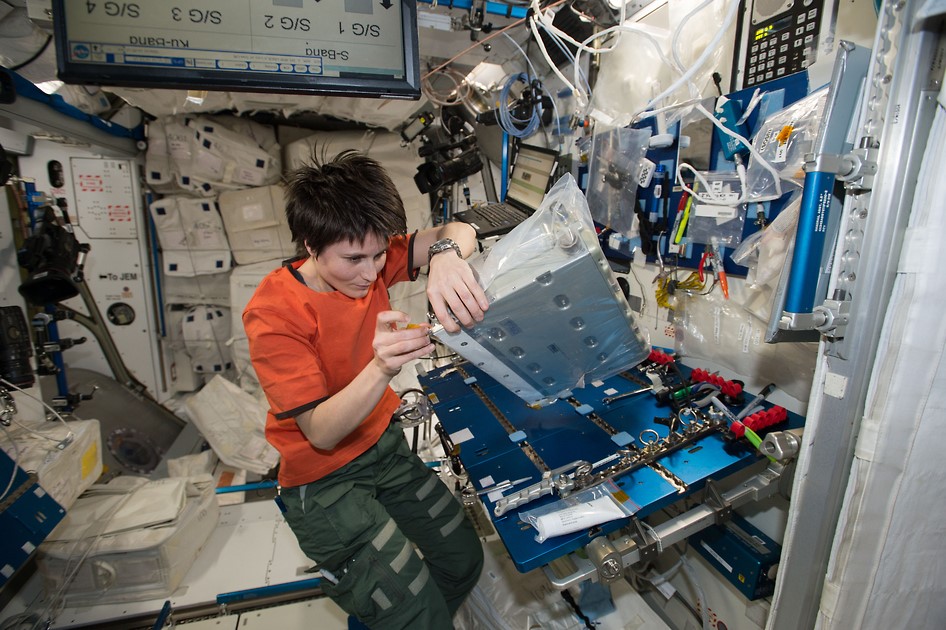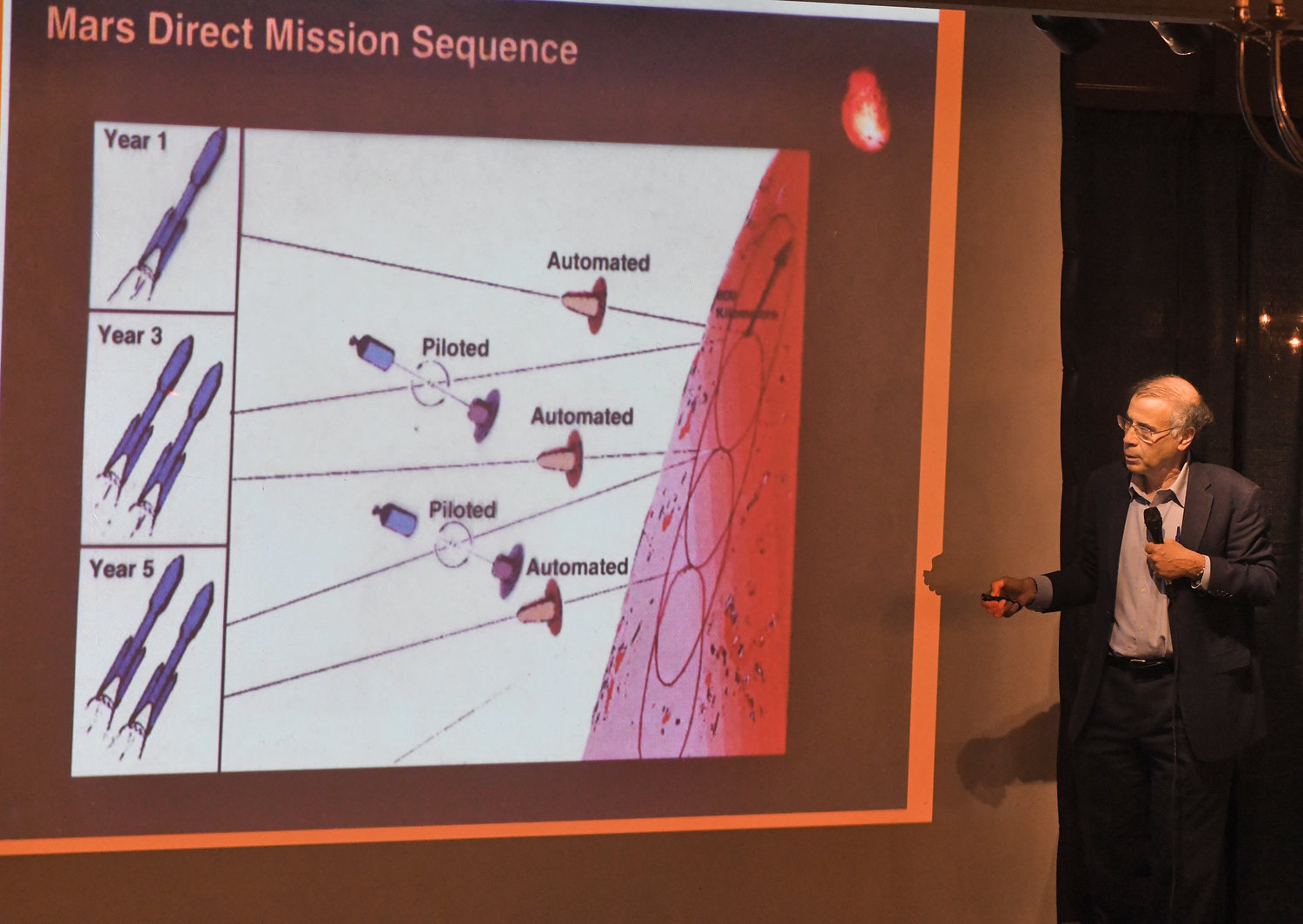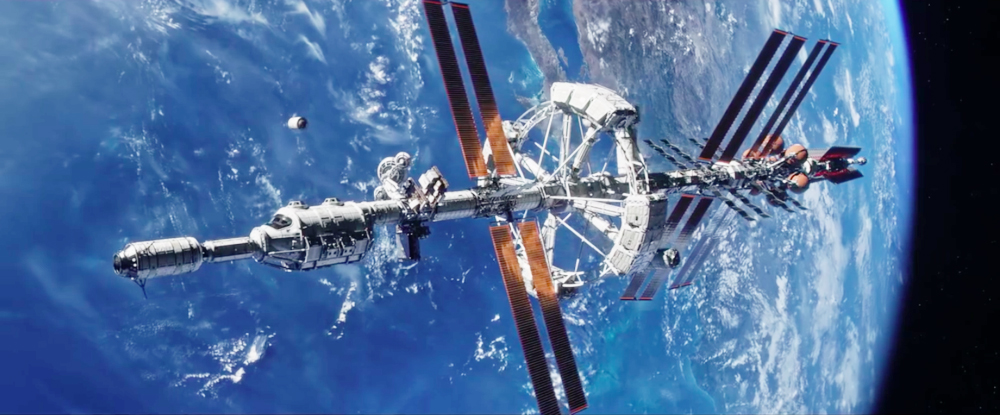= ASTRONAUTICAL EVOLUTION =
Issue 153, 12 April 2020 – 51st Apollo Anniversary Year
| Site home | Chronological index | Subject index | About AE |
Read this post on Wordpress if you wish to leave a comment
Artificial Gravity for the Journey to Mars and Return
So, here we are 59 years after Yuri Gagarin’s flight, and there has still not yet been any serious attempt to try out artificial gravity in space, or any serious proposal to do so in the immediate future.
That’s not to say there hasn’t been some serious thinking about it. Watch the video “Artificial Gravity” by Prof. David Kipping at the Cool Worlds YouTube channel for an instructive primer on the subject.
The weirdness of weightlessness
The latest issue of Spaceflight magazine contains an article by space medicine expert Brett Gooden, summarising what we know so far about the response of the human body to microgravity.
He asks: could we confidently despatch a crew now on a two-year mission to Mars and expect a successful outcome?
His answer is: no, we could not, because – assuming the interplanetary flights to be carried out in microgravity – the physical resilience of even a crew that was perfectly fit at launch would be likely to be overwhelmed by the biomedical problems encountered:
- Loss of balance in the inner ear – fortunately the resulting motion sickness usually clears up within 48 hours of entering microgravity;
- Changes to the heart and blood vessels, leading to faintness (orthostatic hypotension) on return to Earth’s gravity (or presumably also exposure to even partial gravity on Mars);
- A transfer of blood from the lower to the upper body, which in addition to causing the superficial symptoms of a puffy face and anaemic chicken-legs has a detrimental effect on vision;
- Loss of muscle and bone mass (the latter leading to dangerous calcification of soft tissues);
- Increased skin sensitivity, apparently with greater sensitivity to pain in the hands and feet.
The consequences for a group of human explorers of Mars would be severe enough to “court disaster”, according to Dr Gooden. The problem is not really living in microgravity, or even living in one-third Earth gravity. The real show-stoppers are:
- The astronauts must make abrupt transfers from Earth gravity, to microgravity, to Mars gravity, to microgravity, and finally back to Earth gravity;
- Each of those changes is accompanied by sudden stresses of multiple-gee loads and vibration for a period of several minutes.
Given time, one’s body can adapt more or less successfully to microgravity, and presumably also to martian gravity, but each adaptation leaves the traveller unfit to face the transfer to the next state. This applies particularly to coming out of microgravity to land on Mars. During the landing itself the astronauts will be especially vulnerable to blacking out, and after landing they will risk falling over and breaking one of their weakened bones, just as elderly people do on Earth.
Dr Gooden mentions the idea of mitigating the problem with artificial gravity. His proposal is to get astronauts to run around the circumference of their habitat like hamsters in an exercise wheel, thus both generating their own gravity and engaging in impact exercise. This was done by the occupants of the 6.6-metre diameter Skylab in the early 1970s, who presumably invented the practice spontaneously.
This is hardly a satisfactory solution to the problem, being little more than a variant on the current obsession with physical exercise on board (two hours per day per astronaut!).
The goodness of gravity
In an article in Spaceflight in 2017, based on a blog post, I suggested a number of guidelines for flights to Mars, one of which was artificial gravity on the interplanetary journeys in both directions. I took the idea up in more detail in a paper which appeared in JBIS in 2018.
Clearly, the best-known proponent of artificial gravity on the way to Mars and back is Robert Zubrin, who introduced it in the Mars Direct strategy described in his groundbreaking book The Case for Mars (first published in 1996). Although I used the essence of his scheme for my JBIS paper, I found I needed to modify it.
Zubrin envisages his spacecraft using its upper rocket stage as a counterweight, and coupling the two together using cables. This design is clearly seen in the photo on the right (in which Zubrin reproduces figure 1.2 from chapter 1 of his book). It has three problems:
- The spacecraft flies alone, without support, and is therefore vulnerable to an Apollo-13-type accident;
- The upper rocket stage is discarded just before arrival at Earth or Mars, and lost;
- Rotation of a long, narrow object is unstable – see the T-handle experiment on the ISS for a vivid demonstration of this.
My JBIS paper fixed the first two of these problems by having two spacecraft fly in tandem. Each spacecraft serves as counterweight to the other for artificial gravity, and each serves as lifeboat to the other in the event of an accident.
Incidentally, Zubrin’s scheme suffers from a further problem in that his Earth return spacecraft is much too small to guarantee the crew’s safety on the Mars to Earth leg of the mission. This can be rectified by making them larger (two flying in tandem, as before), and leaving a rocket stage waiting for them in low Mars orbit. The parking of resources in orbit is described by Zubrin as Mars Semi-Direct; his aversion to any Mars orbit rendezvous manoeuvres seems to be based more on a purist rejection of the official architectures – which resemble Apollo with a massive mother ship left in orbit – than on a dispassionate balancing of risks and benefits.
This leaves the problem of rotational instability.
Surprisingly, the JBIS reviewer of my paper did not pick me up on this. But it is still a loose end which needs to be tidied up.
The form which allows for the most stable rotation is a disk or wheel shape, like the living-quarters in the fictional Hermes spacecraft in Andy Weir’s novel The Martian, shown here from the movie. But the wheel on Hermes is on the small side: although exact experiments have not yet been done, it seems probable that in order to avoid motion sickness one needs a lever arm of at least the 85 metres or so that Zubrin allows (giving him Mars-equivalent artificial gravity at a rotation speed of 2 r.p.m.; p.8 of the Touchstone 1997 edition).
The question is therefore whether there is a way of assembling the small spacecraft which are all that an early Mars programme could probably afford into a wheel shape. While having two ships and a tether between them is probably unstable, expanding that to three or more ships spaced equidistantly around the axis of rotation – at the corners of a triangle, a square, a pentagon, etc. – would remove the instability.
Perhaps an ideal system would have four individual spacecraft making the interplanetary crossing together. Rather than using tethers it might be better to have a double rigid truss in the form of a cross, with docking points at all four tips, access tunnels built into the four arms, a large dish antenna, and storage tanks for additional supplies attached near the centre.
This revives a concept which I called a Service Platform when I was sketching Earth-Mars architectures. It would be a relatively light piece of kit that would be parked in Earth orbit or Mars orbit when not being used in interplanetary space. Perhaps it’s time to start thinking about that idea again.
References
Brett Gooden, “A matter of survival”, Spaceflight, May 2020, p.26-33. Dr Gooden has been involved with space medicine since project Mercury, with articles appearing in Spaceflight as early as March 1964 and again in May 1965.
Stephen Ashworth, “Evaluating Mars programme designs”, Spaceflight, September 2017, p.336-342.
Stephen Ashworth, “An Earth-Moon-Mars Passenger Transport Pyramid”, JBIS, vol.71 no.5 (May 2018), p.165-177.
To make comments, please visit this post on Wordpress.
| Site home | Chronological index | About AE |


